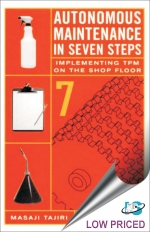Tab Article
Autonomous maintenance is an especially important pillar of Total Productive Maintenance (TPM) because it enlists the intelligence and skills of the people who are most familiar with factory machines-- equipment operators. Operators learn the maintenance skills they need to know through a seven-step autonomous maintenance program. Most companies in the West stop after implementing the first few steps and never realize the full benefits of autonomous maintenance. This book contains comprehensive coverage of all seven steps--not just the first three or four.
It includes :
- An overview of autonomous maintenance features and checklists for step audits to certify team achievement at each AM step.
- TPM basics such as the six big losses, overall equipment effectiveness (OEE), causes of losses, and six major TPM activities.
- An implementation plan for TPM and five countermeasures for achieving zero breakdowns.
- Useful guidelines and case studies in applying AM to manual work such as assembly, inspection, and material handling.
- Integrates examples from Toyota, Asai Glass, Bridgestone, Hitachi, and other top companies.
By treating machines as partners and taking responsibility for them, you get machines that you can rely on and help maintain an energized and responsive workplace. For companies that are serious about taking autonomous maintenance beyond mere cleaning programs, this is an essential sourcebook and implementation support.


